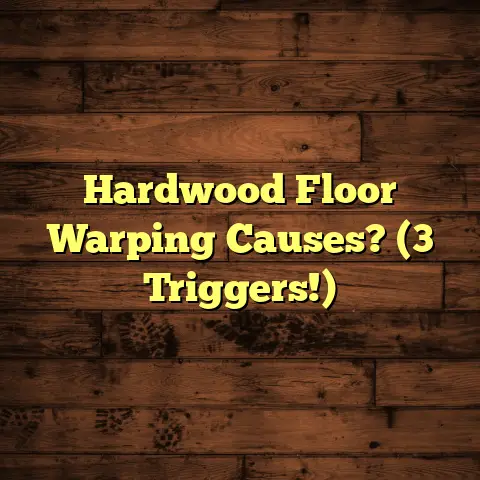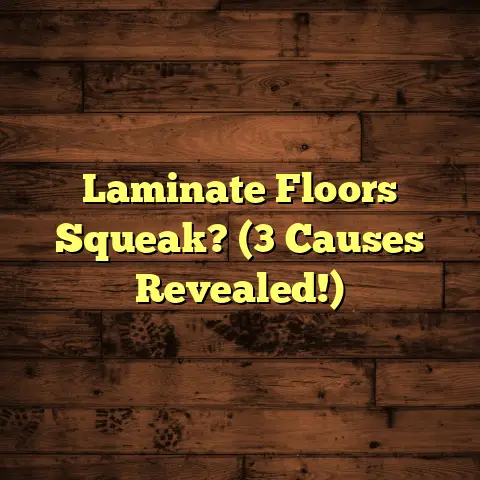Simple Green On Wood Floors? (2 Big Mistakes!)
I’m Mike, your friendly neighborhood flooring contractor.
I’ve seen it all when it comes to wood floors – the good, the bad, and the downright ugly.
And lately, I’ve been hearing a lot about people using Simple Green to clean their wood floors.
Now, I get it.
We all want to use eco-friendly products, and Simple Green has a great reputation.
But trust me, using it on your wood floors can be a recipe for disaster if you’re not careful.
I’m talking about potential damage that can leave you with dull, scratched, or even discolored floors.
That’s why I’m writing this article.
I want to help you avoid the two biggest mistakes I see homeowners make when using Simple Green on wood floors.
I’ll also share some tips on how to properly clean and maintain your wood floors so they look their best for years to come.
So, grab a cup of coffee, settle in, and let’s get started!
Here’s what we’ll be covering:
-
Understanding Simple Green and Its Composition: What’s in it, and why is it so popular?
-
Mistake #1 – Using Simple Green in Concentrated Form: Why dilution is key.
-
Mistake #2 – Neglecting to Test a Small Area First: The importance of a patch test.
-
Best Practices for Cleaning Wood Floors: Safer alternatives and maintenance tips.
Understanding Simple Green and Its Composition
Okay, let’s dive into what Simple Green actually is.
It’s a popular all-purpose cleaner known for being non-toxic and biodegradable.
That’s a big win for those of us trying to be more eco-conscious!
The main active ingredients in Simple Green are typically:
- Water
- Surfactants (for cleaning)
- Citric acid (for pH control)
- Fragrance
These ingredients work together to break down dirt, grease, and grime, making it a pretty powerful cleaner.
I often recommend it for cleaning countertops, appliances, and even some outdoor surfaces.
However, the key here is that Simple Green is designed to be diluted with water.
This is crucial, especially when we’re talking about wood floors.
Why?
Well, the concentrated form can be a bit too harsh for certain finishes, as we’ll discuss shortly.
Now, you might be thinking, “If it’s so gentle, why can’t I just use it full strength?”
That’s a fair question, and it leads us to our first big mistake…
Mistake #1 – Using Simple Green in Concentrated Form
This is where things can go wrong quickly.
I’ve seen so many homeowners make this mistake, and the results are never pretty.
Using Simple Green in its concentrated form on wood floors can strip away the finish, leaving them dull and vulnerable to scratches.
Think of it like this: your wood floor’s finish is like a protective shield.
It’s what gives your floors their shine and protects the wood from moisture and wear.
When you use a concentrated cleaner, it can break down that shield, leaving the wood exposed.
I’ve even seen cases where it’s caused discoloration or cloudiness on the finish.
Trust me, refinishing your floors is a lot more expensive and time-consuming than properly diluting your cleaner!
The Importance of Dilution
Simple Green is formulated to be mixed with water.
Dilution helps reduce its strength, making it safe for a wider range of surfaces, including wood floors.
The right dilution ratio ensures that you’re getting the cleaning power you need without damaging the finish.
How Concentrated Simple Green Can Damage Wood Floors
The concentrated formula can dissolve or weaken certain types of wood floor finishes.
This can lead to a dull appearance over time.
It can also make the floor more susceptible to scratches and other damage.
Step-by-Step Guide: Properly Diluting Simple Green for Wood Floors
Okay, so how do you avoid this disaster?
It’s simple: dilute, dilute, dilute!
Here’s my recommended method:
Check the Label: Always read the Simple Green label for specific dilution instructions.
They may have different recommendations for different surfaces.Ideal Ratio: A general rule of thumb for wood floors is to use a very diluted solution.
I recommend starting with 1/4 cup of Simple Green per gallon of water.
That’s a ratio of 1:64.-
Mix Thoroughly: Use a clean bucket and mix the Simple Green and water thoroughly.
Test First: Before cleaning the entire floor, test the solution on a small, inconspicuous area to ensure it doesn’t damage the finish.
(More on this in Mistake #2!)
Tips for Mixing Solutions Effectively
-
Use Warm Water: Warm water helps the Simple Green dissolve and mix more easily.
Don’t Overdo It: More Simple Green doesn’t mean a better clean.
Stick to the recommended ratio.Fresh Solution: Mix a fresh solution each time you clean.
Don’t store diluted Simple Green for extended periods.
Real-Life Anecdotes: The Costly Mistakes
I’ve had clients call me in a panic after using concentrated Simple Green on their floors.
One woman used it full strength because she thought her floors were “extra dirty.”
The result?
A hazy film that wouldn’t come off, and she ended up having to get her floors professionally buffed and re-coated.
Another client used a slightly less diluted solution, but still noticed a dullness after a few months.
They caught it early enough, and we were able to restore the shine with a professional cleaning and polishing.
The lesson here is clear: Dilution is key!
Mistake #2 – Neglecting to Test a Small Area First
Alright, let’s move on to the second big mistake I see people make:
Skipping the patch test.
I know, I know, it sounds like an extra step, and who has time for that?
But trust me, this little step can save you a whole lot of heartache (and money) in the long run.
The Significance of Testing
Wood floors come in all shapes and sizes, and so do their finishes.
What works on one floor might not work on another.
Different types of wood (oak, maple, pine, etc.) and different types of finishes (polyurethane, varnish, wax, etc.) can react differently to cleaning products.
That’s why it’s crucial to test your cleaning solution on a small, inconspicuous area before you go slathering it all over your beautiful floors.
The Risks of Skipping the Test
If you skip the test, you’re essentially rolling the dice.
You could end up with:
- Discoloration: The cleaner might react with the finish and cause it to change color.
- Damage to the Finish: The cleaner could strip away the finish, leaving the wood exposed.
- Adverse Reactions: The cleaner could cause the finish to bubble, crack, or peel.
These are all things you definitely want to avoid!
Detailed Guide: Conducting a Patch Test
Okay, so how do you do a patch test? It’s easier than you think:
-
Choose an Inconspicuous Spot: Pick a spot that’s out of the way, like in a closet, under a rug, or in a corner.
-
Prepare Your Solution: Mix your Simple Green solution according to the dilution instructions we discussed earlier.
-
Apply the Solution: Use a clean cloth to apply a small amount of the solution to the test area.
Wait and Observe: Let the solution sit for the amount of time you’d typically leave it on the floor when cleaning (usually a few minutes).
Then, wipe it off with a clean, damp cloth.-
Check for Reactions: Wait 24 hours and check the test area for any signs of discoloration, damage, or adverse reactions.
Proceed with Caution: If everything looks good, you can proceed to clean the rest of your floors.
If you notice any problems, stop immediately and consider using a different cleaner.
Cautionary Tales: The High Cost of Skipping the Test
I had a client who skipped the patch test and ended up with a large, discolored spot right in the middle of her living room floor.
She had to hire a professional to sand down and refinish the entire floor, which cost her thousands of dollars.
Another client used a cleaner that caused their finish to peel, and they had to replace the entire floor.
These stories are extreme, but they illustrate the importance of taking that extra step to protect your investment.
Best Practices for Cleaning Wood Floors
Alright, now that we’ve covered the two big mistakes, let’s talk about best practices for keeping your wood floors clean and beautiful.
Alternatives to Simple Green
While Simple Green can be used safely on wood floors with proper dilution and testing, there are other eco-friendly options that are specifically designed for wood.
Here are a few of my favorites:
Bona Hardwood Floor Cleaner: This is a popular choice that’s specifically formulated for wood floors.
It’s pH-neutral and won’t damage the finish.-
Method Squirt + Mop Hardwood Floor Cleaner: This is another great option that’s made with plant-based ingredients and is safe for wood floors.
Vinegar and Water: A classic, inexpensive, and effective cleaner.
Mix 1/2 cup of white vinegar with 1 gallon of water.
Regular Cleaning Routines
The key to keeping your wood floors looking their best is to establish a regular cleaning routine.
Here’s what I recommend:
-
Daily Sweeping or Vacuuming: Use a soft-bristled broom or a vacuum with a soft floor attachment to remove dust, dirt, and debris.
-
Weekly Mopping: Use a damp mop (not soaking wet!) with your chosen wood floor cleaner.
-
Spot Cleaning: Clean up spills immediately to prevent staining or damage.
Types of Mops to Use
When it comes to mopping wood floors, the type of mop you use matters.
Here are a few options:
-
Microfiber Mop: These mops are great for picking up dirt and dust, and they’re gentle on wood floors.
-
Spray Mop: These mops have a built-in sprayer that allows you to apply the cleaning solution directly to the floor.
-
Traditional Mop: If you use a traditional mop, make sure to wring it out thoroughly so it’s only damp.
The Importance of Using the Right Cleaning Products
Using the wrong cleaning products can damage your wood floors, so it’s important to choose wisely.
Avoid using:
-
Abrasive Cleaners: These can scratch the finish.
-
Bleach: This can discolor the wood.
-
Ammonia-Based Cleaners: These can damage the finish.
Professional Cleaning vs. DIY Methods
While DIY cleaning can be effective for regular maintenance, professional cleaning can provide a deeper clean and help restore the shine to your floors.
Professional cleaners have the equipment and expertise to remove stubborn dirt and grime without damaging the finish.
I generally recommend getting your wood floors professionally cleaned every 12-18 months.
Maintaining the Finish
The finish is what protects your wood floors, so it’s important to maintain it properly.
Here are a few tips:
-
Use Furniture Pads: Place felt pads under the legs of your furniture to prevent scratches.
-
Avoid High Heels: High heels can dent and scratch wood floors.
-
Use Area Rugs: Place area rugs in high-traffic areas to protect the finish.
-
Re-Coat as Needed: Depending on the type of finish, you may need to re-coat your floors every few years to maintain their protection and shine.
Conclusion
So, there you have it: the two big mistakes people make when using Simple Green on wood floors, and how to avoid them.
Remember:
-
Dilute, dilute, dilute! Using Simple Green in concentrated form can strip the finish off your floors.
-
Test, test, test! Always test your cleaning solution on a small, inconspicuous area before cleaning the entire floor.
By following these simple tips and using the right cleaning products, you can keep your wood floors looking their best for years to come.
I hope this article has been helpful.
Now, I’d love to hear from you!
What are your favorite tips for cleaning wood floors?
Have you ever had a cleaning disaster?
Share your experiences in the comments below!
And remember, if you’re ever unsure about how to clean your wood floors, it’s always best to consult with a professional.
Happy cleaning!





